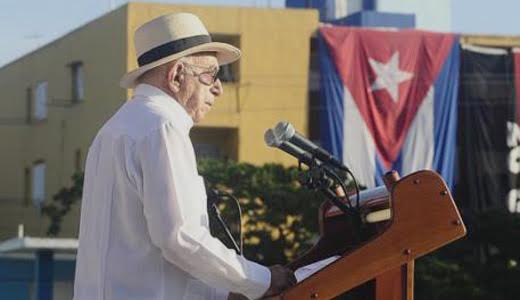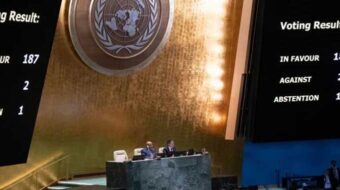
Once more in Cuba July 26 has come and gone. For Cubans the day is a “National Day of Rebellion;” it’s their greatest holiday. As always, ceremonies and festivities took place this year throughout the island. Sancti Spiritus, the capital city of Sancti Spiritus province, hosted the main event. Cuban President Raul Castro presided over the gathering there, and Jose Ramon Machado Ventura addressed the crowd. He’s a vice president of Cuba’s Council of State and second secretary of the Communist Party.
National leaders, foreign visitors in solidarity with Cuba’s revolution, and local political leaders and citizens – about 8000 people in all – filled the city’s central plaza. The signature event of the July 26 celebrations each year takes place in a province selected because of accomplishments. The speakers in Sancti Spiritus cited the province’s advances in agricultural production, tourist facilities, in the energy sector, and in health care, especially its very low infant mortality rate.
July 26 in Cuba commemorates the day in 1953 when youthful armed rebels attacked military installations in eastern Cuba, one in Bayamo and the other in Santiago – the now famous Moncada barracks. The assaults failed utterly. Dozens of captured rebels were tortured and/or killed. Nevertheless, revolutionaries, calling themselves the July 26 movement, went on to defeat the U. S. supported dictatorship of Fulgencio Batista. In doing so, they launched the Cuban project of building a socialist society.
Fidel Castro, who led the attacks and later on the July 26 movement, went on trial. Defending himself, Castro, who was a lawyer, explained why Cuba needed a revolution. He explored philosophical, historical, sociological, and idealistic justifications for the uprising. Castro identified tasks for revolutionaries after they gained victory. The printed version of his defense, titled “History Will Absolve Me,” circulated in Cuba beginning in 1954. Its English language version, 26,203 words long, surely warrants study now, 63 years after that court session.
Why “Day of Rebellion”?
Every year speakers at the July 26 celebrations recall the revolutionaries’ martyrdom, imprisonment, or exile; their military struggle in Cuba’s Sierra Maestra after December 1956; their mobilizations in the cities; and their ultimate victory.
Ostensibly the day marks the beginning of a political revolution. But one wonders about the imprecise and bland label of “National Day of Rebellion.” Mere rebellion is not enough to propel a social revolution such as Cuba’s. So why is not the term “revolution” used?
Here’s a theory. Cubans, students and adults alike, might object to a name suggesting that the revolution began only on July 26, 1953. They recall political and social revolutionaries of the 19th century who carried out slave rebellions and fought in Cuba’s first war for independence from Spain. They know about General Antonio Maceo whose Protest of Baraguá in 1878 kept alive fights for independence and slavery’s abolition.
Above all, they honor José Martí. His anti-imperialism, his propagandizing and organizing for the second war for independence, and his battlefield death in 1895 inspired the revolutionaries of 1953. They were the “generation of the centennial” of José Martí’s birth.
Fidel Castro told his accusers in 1953 that, “It looked like the Apostle (Martí) was going to die in the year of his centennial, that his memory would be blighted for always; that was such an affront!”
Revolutionaries laid siege to the Machado dictatorship (1925 – 1933). They agitated and suffered on behalf of revolutionary change amid the turmoil preceding Batista’s ascendency in 1934. In short, the July 26 heroes inherited a revolutionary tradition. Cuba’s revolution hardly began in 1953, but that year Cuban rebelliousness did strike again, and with momentous effects.
A day to celebrate
From the perspective of history, July 26 in Cuba testifies to a social and political revolution that accomplished much. It joins others like July 4 in the United States, July 14 in France, and October 25 (Julian calendar) in Russia. Only later did a revolution within a revolution convert Cuba’s revolution into a socialist one. In fact, revolutions leading to changes on a seismic scale are few, and Cuba’s is one of them. July 26 thus is a big day everywhere.
Concluding his remarks in Sancti Spiritus, Vice President Jose Ramon Machado Ventura called upon Cubans “each day to show, in every workplace and with concrete actions” that they could meet current challenges, “as did the Generation of the Centenary on that July 26, 1953 and as so many Cubans have done throughout their exemplary history of struggles and victories for the homeland.”
Photo: José Ramón Machado Ventura, second secretary of the Communist Party of Cuba and a vice president of the Councils of State and Ministers, during the commemoration of the 63rd anniversary of the assaults on the Moncada and Carlos Manuel de Céspedes Garrisons, held in Sancti Spíritus, July 26. Estudio Revolución












Comments